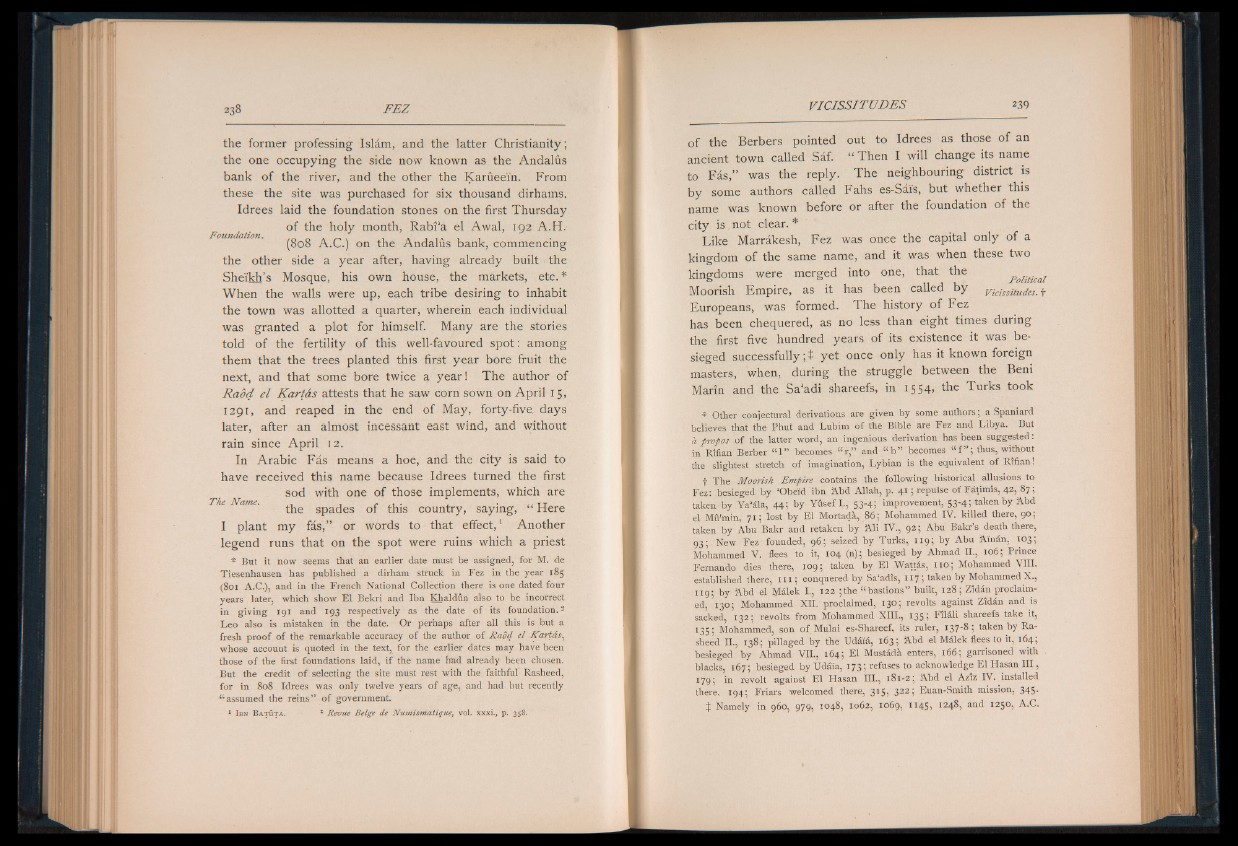
the former professing Islam, and the latter Christianity;
the one occupying the side now known as the Andalus
bank of the river, and the other the Karueein. From
these the site was purchased for six thousand dirhams.
Idrees laid the foundation stones on the first Thursday
of the holy month, Rabi'a el Awal, 192 A.H.
Foundation. i A
(808 A.C.) on the Andalus bank, commencing
the other side a year after, having already built the
Sheikh’s Mosque, his own house, the markets, etc. *
When the walls were up, each tribe desiring to inhabit
the town was allotted a quarter, wherein each individual
was granted a plot for himself. Many are the stories
told of the fertility of this well-favoured sp o t: among
them that the trees planted this first year bore fruit the
next, and that some bore twice a year! The author of
Raod el Kart&s attests that he saw corn sown on April 15,
1291, and reaped in the end of May, forty-five, days
later, after an almost incessant east wind, and without
rain since April 12.
In Arabic Fas means a hoe, and the city is said to
have received this name because Idrees turned the first
sod with one of those implements, which are
the spades of this country, saying, “ Here
I plant my fas,” or words to that effect,1 Another
legend runs that on the spot were ruins which a priest
* But it now seems that an earlier date must be assigned, for M. de
Tiesenhausen has published a dirham struck in Fez in the year 185
(801 A.C.), and in the French National Collection there is one dated four
years later, which show El Bekri and Ibn Khaldun also to be incorrect
in giving 191 and 193 respectively as the date of its foundation.2
Leo also is mistaken in the date. Or perhaps after all this is but a
fresh proof of the remarkable accuracy of the author of Raod el Kartas,
whose account is quoted in the text, for the earlier dates may have been
those of the first foundations laid, if the name h'ad already been chosen.
But the credit of selecting the site must rest with the faithful Rasheed,
for in 808 Idrees was only twelve years of age, and had but recently
“ assumed the reins” of government.
1 I b n B a t u t a . * Revue Beige de Numismatique^ v o l. xxxi., p . 358.
of the Berbers pointed out to Idrees as those of an
ancient town called Sáf. “ Then I will change its name
to Fás,” was the reply. The neighbouring district is
by some authors called Fahs es-Safs, but whether this
name was known before or after the foundation of the
city is not clear. *
Like Marrákesh, Fez was once the capital only of a
kingdom of the same name, and it was when these two
kingdoms were merged into one, that the
Moorish Empire, as it has been called by vicissitudes. +
Europeans, was formed. The history of Fez
has been chequered, as no less than eight times during
the first five hundred years of its existence it was besieged
successfully ; í yet once only has it known foreign
masters, when, during the struggle between the Beni
Marin and the Sa’adi shareefs, in 1554, the Turks took
* Other conjectural derivations are given by some authors; a Spaniard
believes that the Phut and Lubim of the Bible are Fez an4 Libya. But
a p ropos of the latter word, an ingenious derivation has been suggested:
in Riñan Berber “ 1” becomes “ r,” and “ b ” becomes “ f ” ; thus, without
the slightest stretch of imagination, Lybian is the equivalent of Riñan!
f The Moorish Empire contains the following historical allusions to
Fez: besieged by ’Obeid ibn Abd Allah, p. 4 15 repulse of Fátimis, 42, 87;
taken by Ya’ála, 44; by Yüsef I,, 53-4; improvement, 53-4 ; taken by Abd
el Mú'min, 71; lost by El Mortada, 86; Mohammed IV. killed there, 90;
taken by Abu Bakr and retaken by Ali IV., 92; Abu Bakr’s death there,
93; New Fez founded, 96; seized by Turks, 119; by Abu Ainán, 103;
Mohammed V. flees to it, 104 (n); besieged by Ahmad II., 106; Prince
Fernando dies there, 109; taken by El Wattás, n o ; Mohammed VIII.
established there, m l eonquered by Sa’adis, 117; taken by MohammedX.,
119; by Abd el Mulek I., 122 ; the “ bastions ” built, 128; Zidán proclaimed,
130; Mohammed XU. proclaimed, 13° 1 revolts against Zidán and is
sacked, 132; revolts from Mohammed XIII., 1351 Eiláli shareefs take it,
135; Mohammed, son of Mulai es-Shareef, its ruler, 137-8; taken by Rasheed
II., 138; pillaged by the Udáíá, 163; Abd el Málek flees to it, 164;
besieged by Ahmad VII., 164; El Mustáda enters, 166; garrisoned with
blacks, 167; besieged by Udáta, 173 j refuses to acknowledge El Hasan HI,
179; in revolt against El Hasan III., 181-2; Abd el Aziz IV. installed
there, 194; Friars welcomed there, 315, 322; Euan-Smith mission, 345.
J Namely in 960, 979, 1048, 1062, 1069, 114S1 1248, and 1230, A.C.